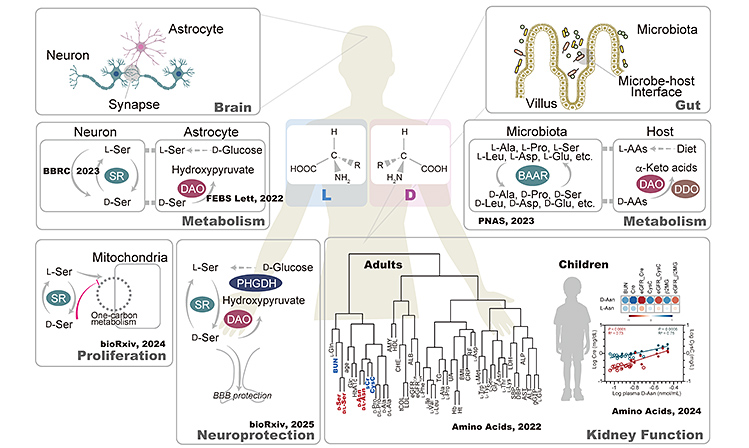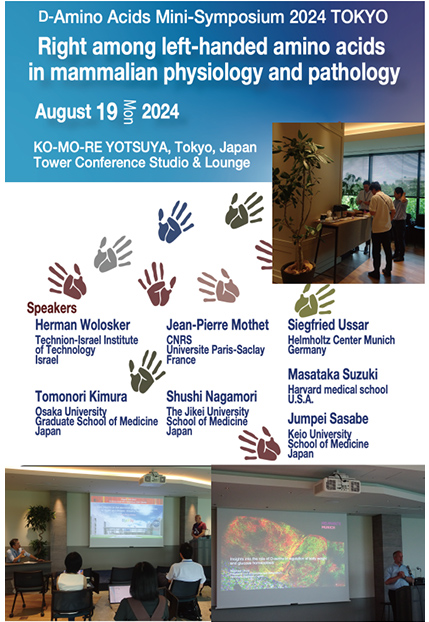Research outcomes of the Program for the Advancement of Next Generation Research Projects
School of Medicine
Jumpei Sasabe
Chirality is the property that a molecule cannot be superimposed on its mirror image, similar to the relationship between the right and left hands. The exclusive use of L-amino acids in a homochiral manner is considered a signature of life. However, recent advances in analytical science have revealed that the homochirality of L-amino acids is occasionally broken in many organisms including mammals, and that D-amino acids also exist albeit at minor levels. This discovery has raised the possibility that D-amino acids may play regulatory roles in a variety of biological processes. This study aimed to elucidate the mechanisms by which L-amino acid homochirality is disrupted in mammals and to clarify the physiological and pathophysiological significance of D-amino acids.

Figure 1:
Overview of our studies supported by "Program for the advancement of Next Generation Research Project". D-amino acids are synthesized in the brain and gut. We found that the chiral balance of amino acids is regulated by enzymes in the neurons, astrocytes, gut epithelium, and renal tubules. D-serine inhibits cellular proliferation in cancer cells by competing with L-serine for mitochondrial transport, and it also counteracts motor impairment caused by inflammatory demyelination. Plasma levels of D-serine and D-asparagine reflect kidney function in both adults and children, suggesting their potential as diagnostic biomarkers for kidney diseases.
© Jumpei Sasabe, Keio University
From a metabolic perspective, a comprehensive analysis of chiral amino acids in human body fluids revealed that D-amino acids correlate with renal function, while L-amino acids correlate with metabolic parameters (Amino Acids, 2022). In the central nervous system, we found that D-amino acid catabolism occurs specifically in astroglia (FEBS Lett, 2022). It was further demonstrated that 10% of D-serine in the central nervous system is synthesized by an unidentified mammalian enzyme (BBRC, 2023). We also revealed that L-amino acids in the intestine undergo dynamic chiral conversion by symbiotic microbiota, and that chiral homeostasis of amino acids is maintained through enzymatic catabolic reactions and renal excretion (PNAS, 2023). Additionally, it was found that blood D-asparagine levels are a useful biomarker for renal failure in children (Amino Acids, 2024).
From a functional perspective, D-amino acids derived from symbiotic bacteria exhibit diurnal fluctuations in accordance with microbial dynamics in the gut, suggesting a potential role in the endocrinal regulation of host physiological processes (in preparation). Furthermore, we found that inflammatory demyelinating diseases in humans show a chiral imbalance in serine of cerebrospinal fluid, and endogenous D-serine suppresses inflammatory demyelination (bioRxiv, 2025). Additionally, D-serine was found to inhibit one-carbon metabolism by competing with L-serine for transport into mitochondria, demonstrating tumor growth inhibition ex vivo (bioRxiv, 2024).

Figure 2:
Organizing and hosting the "D-Amino Acid mini-Symposium 2024 TOKYO", held in Yotsuya, Aug 2024.
© Jumpei Sasabe, Keio University
In summary, our findings reveal that the disruption of amino acid homochirality is not merely a biochemical anomaly, but a regulated and functionally significant phenomenon in mammals. D-amino acids, though present in minor amounts, exhibit distinct metabolic dynamics and physiological roles, influencing processes such as renal function, circadian rhythm regulation, immune response, and tumor metabolism. These insights highlight the emerging importance of amino acid chirality in both health and disease, offering new perspectives for understanding mammalian biology and developing novel diagnostic and therapeutic strategies.
On August 19, 2024, we organized a symposium on amino acid chirality (D-Amino Acids Mini-Symposium 2024 TOKYO), which featured presentations from three researchers from France, Germany, and Israel, as well as four Japanese researchers. The event facilitated lively discussions and proved to be a highly productive meeting.
We gratefully acknowledge the support provided by the "Program for the Advancement of Next Generation Research Projects," which enabled successful completion of this research project on amino acid chirality in mammalian physiology and pathology. The continued support was instrumental in facilitating both experimental studies and international collaborations, including the organization of the symposium.
Keio University Program for the Advancement of Next Generation Research Projects
The Keio University Program for the Advancement of Next Generation Research Projects subsidizes research costs with the aim of finding solutions to challenges and of promoting global academic research in order to allow Keio University faculty members to establish a presence as core researchers.